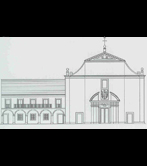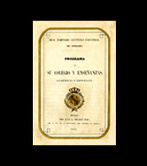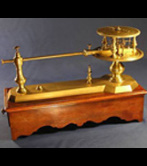The Royal Seminary of Bergara
The Royal Seminary of Bergara represented in itself the greatest achievement of the Real Sociedad Bascongada de Amigos del País (Royal Basque Society of Friends of the Country, or RSBAP), as well as being the one that best reflects the organisation’s concerns regarding education. Furthermore, it constituted an authentic landmark in higher education and research. On 19th August 1769, a Royal Decree by Carlos III ceded to the RSBAP the school that had been run by the Jesuits in Bergara until the order was banned. In November 1776, a seminary was set up there to teach classes in Spanish, Latin, French and English, mathematics, natural sciences and other subjects that would contribute to the education of "the customs, religion and reason of young men".
Two teaching syllabi were drafted. The “general” syllabus contained humanistic and cultural subjects suitable for educating young noblemen: elementary studies, languages, humanities (history, mythology, heraldry, etc.), physics, mathematics, drawing and skills (dancing, music, fencing, horse riding). In the "special education" syllabus, students would study mineralogy, metallurgy, chemistry, public architecture, agriculture, trade and politics. In 1778, professorships were created in chemistry, mineralogy and metallurgy, with support from the State. General education was taught almost exclusively by local teachers, except for the "skills", which were taught by the Frenchman François Duboix. The special education subjects, meanwhile, were taught by specialist teachers from other countries, including the Frenchmen Louis Joseph Proust (chemistry and metallurgy) and François Chabaneaux (physics), and the Swede Anders Nikolaus Tunborg who, together with Jerónimo Mas, replaced Fausto Elhuyar in chemistry. The RSBAP also maintained links with Scottish and French scholars who were unable to come and give classes in Bergara.
In addition to a library and a study, the seminary also had a large laboratory, located in the mansion house of Zabala. The Swede Tunborg claimed that it was four times larger than the ones in Stockholm or Uppsala. Laboratory materials and equipment were brought from France and England, and scientists working here succeeded in isolating wolfram from wolframite, thereby discovering a previously unknown chemical element. Other advances made here include the discovery of a practical method for making platinum malleable, while the laboratory’s scientists also analysed mineral waters and researched various areas, such as sheet iron and tinplate production, the Somorrostro mines and collections of minerals from around the country.
Despite its importance and significance, the real impact that the seminary had on Basque society was rather relative. Firstly, it was not designed for teaching large numbers of students: between 1776 and 1783, average student numbers totalled 55; from 1783 to 1789, the figure stood at 125; finally, between 1789 and 1794, the average was just over 90. Secondly, only a third of the students were Basques; 44% were Spanish (particularly from Andalusia), while 22% came from the colonies, especially Cuba and Mexico.
The War of the Convention brought an end to both the RSBAP and the seminary, which was looted by French troops. As a result, in 1794 it was moved to Vitoria, not to return to Bergara until 1798. In 1848 an agreement was signed to found and build the first Escuela Industrial de la Península (Industrial School of the Peninsula). This finally disappeared in 1892, when it became a secondary school under the Dominican brotherhood.




